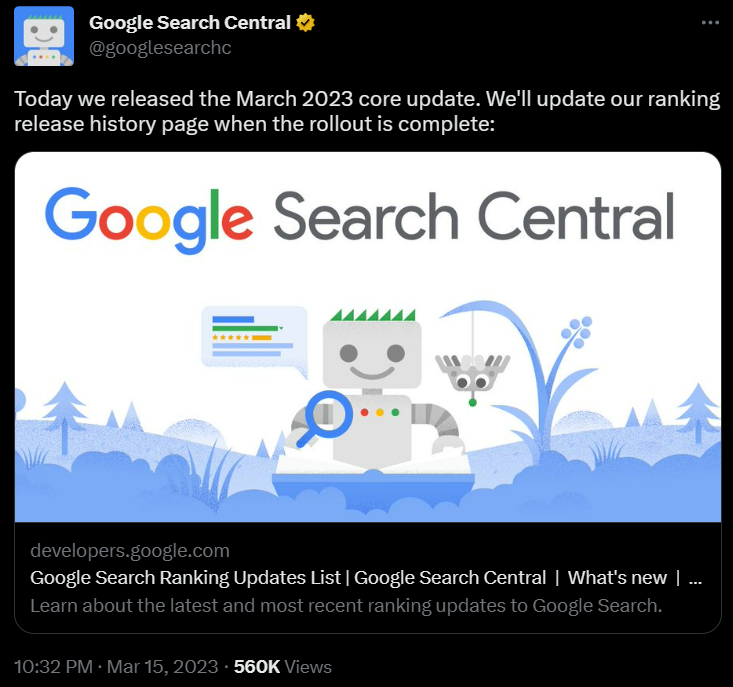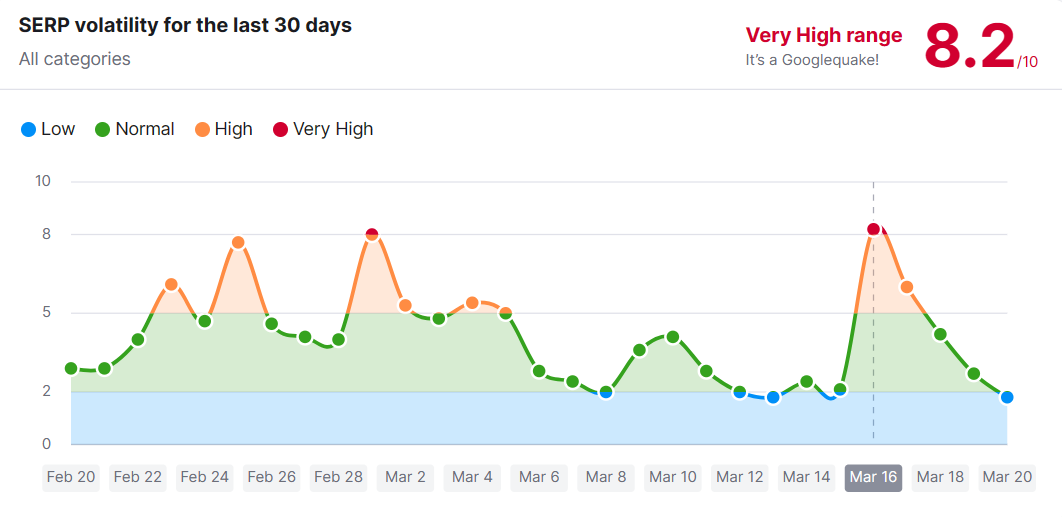Google’s March 2023 Broad Core Update: What You Need To Know
SEOs are once again dealing with another broad core update–the first of 2023. And this one touched down hard and fast, shaking things up more than the previous September 2022 update.
With all the fluctuations and volatility in search results before and after the update, how can you ensure your website comes out as a winner once the dust settles?
Let me discuss my insights and a few key strategies to help you deal with the March 2023 Core Update.
What Does a ‘Broad Core Algorithm’ Update Mean?
The name is self-explanatory. It’s an algorithm update that focuses on broad changes, with no specific focus in each area.
Core updates are made to keep the search results both updated and accurate to user queries. Think of it as similar to a list of recommended restaurants to eat – year to year, there may be newer, better places for you to eat at. Updating this list every few months is pretty similar to a core update in that it keeps your list relevant and up to date.
With each core update, there are often widespread fluctuations in ranking, which ultimately means that your website could either be positively or negatively affected.
The information we get about these updates is limited, as you can see from Google’s official document on core updates and their announcement post. Most of the data and strategies we get from this update are through webmaster tools, expert insights, and speculations.
How often do Google core updates happen?
Generally, they’re released every few months, with the last two being in May and September of 2022. You can check the release dates of all the core updates so far in this document.
Google tends to announce these updates a few days before, or the day of. At times, you might even start to see the effects of one a few days before it’s officially announced.
Once released, it can take several days up to a few weeks to finish rolling out for users.
The March 2023 Core Update
Google’s March 2023 Core Update was released on the 15th of March and officially finished rolling out on the 28th of March, 07:26 PDT.

It took 13 days to roll out, and this update was more noticeable than the last one we had in September 2022.
Here’s a quick rundown of what widely notable effects I and other SEOs have seen so far:
- Target: All types of content, as is usually the case with core updates.
- Penalty: No penalty, focused on promoting or rewarding pages that fit their new algorithm.
- Impact: Global update, impacting all regions, and in all languages. This one hit hard and fast, and we saw significant volatility in the SERPs (more on that later).
- Features: Core updates impact Google’s features, such as Discover, featured snippets, and more.
Just like any other core update from Google, the update seems to reward websites that follow E-E-A-T, high-quality content, and improved user experience. Websites that don’t hit these criteria or practice black hat SEO will likely see significant losses.
This update does not particularly target specific types of websites in fact, the goal of a core update is to improve the quality of the search engine results and make sure every result is relevant to every user by assessing the overall content in the SERPs.
SERP Volatility
Checking the SERP sensors from our various tools, it is noticeable that there were drastic movements in the SERPs, starting from the day after Google released their new broad core update. Below is a snapshot of Semrush’s Sensor:

Diagnosing Issues Caused by an Algorithm Update
Since the algorithm changes in a core update aren’t detailed or explained in any of Google’s official documents, it can be hard to tell if your website has been hit by them.
And, because the updates are made in broader strokes than more specific changes to Google, I’ve found that pages that suddenly drop in the SERPs don’t necessarily have anything ‘wrong’ with them–it might just be that your competition better fits what Google is looking for currently.
All in all, it can be difficult to diagnose whether the losses (or gains) you’re experiencing now are due to the March 2023 Core Update. That said, I understand that those doing less well after this rollout are feeling the need to do something about it.
So, what SEO checklist should you look at to narrow it down?
The Timing
First, check when your pages dropped in ranking or traffic. If it happened within a day or two of the rollout, then there’s a good chance that Google’s algorithms have changed in a way that prefers other sites’ content over yours.
But, there are a few cases where unfortunate timing for landing page optimizations, website revamps, or any other significant changes on your site were made–which can also be the root cause of your problems.
This is when I recommend digging around in your webmaster’s tools.
Search Console
The next step is to check your Google Search Console performance tab. This is where you can find if your impressions and clicks dropped off for specific landing pages.
If significant drops are aligned with the initial rollout date (March 15, 2023) or the official finish date (March 28, 2023), then it’s likely caused by the Core Update.
If so, I suggest looking at the affected landing pages and keywords. You can also look at the ‘Search Appearance’ filter to see which rich results are showing for your site. Segmenting this data can help you understand what keyword clusters or specific site areas were hit by the update.
Analytics
Your Google Analytics profile is another tool I suggest you check. You can combine its data with the insights you found on Google Search Console to see what aspects or content of your website you need to work on.
Go to the Behavior category, and check on your Landing Pages report. Filter the results by ‘Organic Traffic’ to narrow down the data. Here, you can continue to dig into the issues that were revealed to you in your Google Search Console Data.
Use this to benchmark your website’s performance against previous dates, as well.
Competitor Analysis
Performing Competitor Analysis either manually or through SEO tools (such as SE Ranking, Semrush, or Ahrefs) can also highlight what your website is currently missing.
Take a look at your competitors–what are they doing that you currently aren’t? Ask yourself these questions:
- Do they have higher quality content than what you have currently published?
- Do they have higher-quality link-building efforts than you?
- Do they have greater keyword coverage for the products and services you’re offering?
- Are these things you can add to or improve on your website?
Sitewide Effects
Core updates often have a sitewide impact–which means they often affect most of your pages, though not every single page on the site.
If you notice changes on just one page, this is probably not due to a Google core update.
How Can I Optimize My Website for the March 2023 Core Update?
Similar to previous core updates, Google did not provide any specific information about their recent algorithm changes. As a result, there is no definitive procedure on how you can optimize your website following this update. Instead, you’ll have to look at holistic changes to your website and its content.
Google mentioned in their page quality guidelines that practicing E-E-A-T (Experience, Expertise, Authoritativeness, and Trustworthiness) is one of the important things you need to consider to maintain good quality content in the SERPs.
If you’re interested in understanding how to recover from a broad core algorithm update, I have a few key SEO practices to help you:
Improve user experience
This is one of the relevant factors Google considers since they are user-centric. Letting users navigate your website easily will make you gain a high engagement rate online. These are the vital recommendations and some tools I would suggest for you to maintain and improve your website user experience:
- Ensure your website is mobile-friendly: you can check your website’s mobile-friendliness through Google Search Console’s Mobile-Friendly Test.
- Improve page speed: You can use PageSpeed Insights to check your website’s speed on mobile and desktop. This tool also suggests improvements and factors you need to improve on or avoid on your website.
- Improve Readability: check your website regularly and make sure the font details and the positioning of the texts are readable and uniform.
- Improve accessibility and navigation: make sure your website is accessible and navigational to all kinds of users. This includes providing descriptive alt text on images, closed captions on videos, and ensuring compatibility for text, visuals, buttons, etc. on all types of screens.
- Avoid using intrusive ads or pop-ups: this may lower users’ perception of your website, or distract them–both will reduce engagement. Additionally, make sure your website is secure from any kind of online threat.
Create high quality content
Creating high-quality content will always be a must for ranking high and ensuring Google finds your website authoritative.
I’ve written a guide on how to write helpful, informative content (following Google’s most recent content update) if you want to improve your content strategy or revisit your old blogs and landing pages.
Other standard practices you might have to double-check on your website are keyword stuffing, readability, duplicate content, scraped content, and relevance to users. Not following what we consider good practices in these areas can harm your credibility as a website.
If you ever have trouble refreshing your old work or generating new content, you have the option of using generative AI. Tools like ChatGPT and Jasper can help you lessen the time and effort spent on updating your content–though use these tools carefully.
Make sure to proofread and fact-check (as AI tools are never 100% accurate when it comes to data), and add your unique insight and expertise to what they generate. Doing so makes all the difference for your rankings.
Other tools, like Bing AI, can also help generate content, though not on the same level as tools specifically designed for copywriting. Unlike ChatGPT, however, it does have access to the internet and is integrated with OpenAI’s GPT-4. So it can create more informative or insightful answers for you.
Refrain from doing Black Hat SEO
Websites that practice Black Hat SEO may experience spikes in traffic and ranking–but these are inconsistent. And, these practices essentially set you up for future penalization.
Common black hat practices are using hidden headings, texts, or links, duplicating content, spamming, keyword stuffing, and cloaking content or URLs.
Websites that take advantage of these methods will eventually drop off the SERPs, despite the initial visibility boost they can provide.
How Long Will it Take to Recover from the March 2023 Core Update?
SEO, no matter what strategy you decide to use, takes time to show results. It’s why I don’t suggest you wait when it comes to recovering from a core update. Starting right away by reviewing your website and auditing your content will help you stay ahead of the competition and minimize losses as quickly as possible.
Key Takeaway
Google is and will always be user-centric. Changes like the March 2023 core update are meant to improve user satisfaction, and push people-first content to the top of the SERPs.
If you’re one of the many SEO specialists scrambling after this core update, it’s time to step back and start creating a plan. You should focus on improving your website as a whole.
There is no silver bullet to recovering from this, or to jumping back to your initial position. Instead, this update calls for a thorough sweep through your website and analyzing where to improve. If you have not started practicing this, then I encourage you to.
